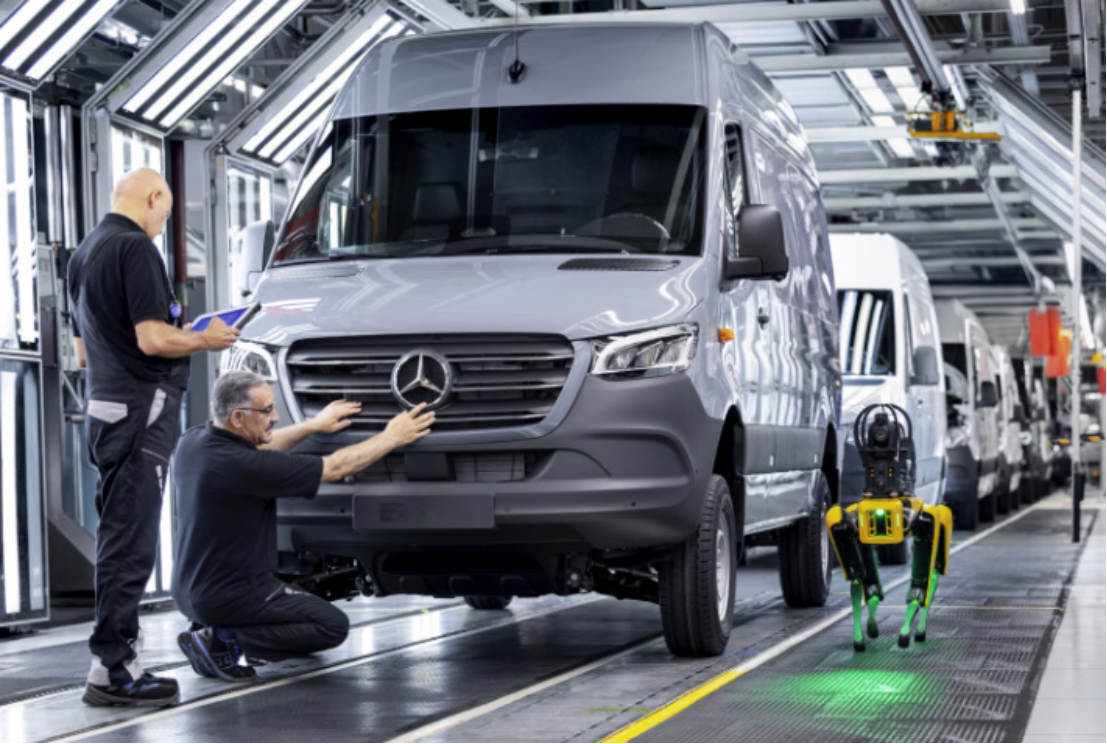Mercedes-Benz Introduces Autonomous Robot System to Reduce Costs and Increase Efficiency
According to foreign media reports, German car manufacturer Mercedes-Benz is accelerating the digitalization strategy of its van factory in Düsseldorf, Germany, and is introducing autonomous robotic systems aimed at reducing costs, increasing efficiency, and preventing system failures.

Image source: Mercedes-Benz France Newsroom
The core of this initiative is a four-legged robotic dog named "Aris." It is reported that Aris is equipped with advanced sensors and artificial intelligence technology, capable of identifying compressed air leaks and detecting anomalies before a failure occurs.
Mercedes-Benz stated that by identifying issues early, Aris can save the factory six-figure euros annually and reduce potential energy consumption by up to 60%.
In addition to leak detection, Aris can also automatically check analog instruments, identify abnormal noise patterns, and autonomously climb stairs to reach various areas of the factory.
This flexibility makes Aris a versatile tool—not only for predictive maintenance but also potentially for more applications in the future, such as inspecting escape routes or assisting in building digital twin models of factories.
By addressing maintenance issues during non-production hours, Aris minimizes costly downtime while extending the lifespan of critical machinery and equipment.
However, despite Aris's impressive performance, Pedro Pacheco, Vice President of Research at Gartner, still believes there is room for expansion in its scope of tasks. "They introduced the robotic dog solely for detecting compressed air leaks, which feels a bit unusual. Its functionality seems relatively limited. I wouldn't say it's a gimmick, but its applications are indeed quite singular."
Despite multiple requests for experts to provide further details about Aris, Mercedes has consistently declined.
Additionally, the German car manufacturer Audi has previously employed a robotic dog named "Spot" to assist in building digital twin models of its factories. It is reported that Spot was developed by the German startup NavVis.
It is worth noting that the International Federation of Robotics released a report in September 2024 indicating that in 2023, robot installations in Europe increased by 9% year-on-year, totaling approximately 92,393 units, with the automotive industry being the main driver of this growth.
【Copyright and Disclaimer】The above information is collected and organized by PlastMatch. The copyright belongs to the original author. This article is reprinted for the purpose of providing more information, and it does not imply that PlastMatch endorses the views expressed in the article or guarantees its accuracy. If there are any errors in the source attribution or if your legitimate rights have been infringed, please contact us, and we will promptly correct or remove the content. If other media, websites, or individuals use the aforementioned content, they must clearly indicate the original source and origin of the work and assume legal responsibility on their own.
Most Popular
-

Dow, Wanhua, Huntsman Intensively Raise Prices! Who Controls the Global MDI Prices?
-

Clariant Unveils Cost-Cutting Plan Details, Plans to Shut Down Multiple Plants
-

[Today's Plastics Market] General Materials Weakly Fluctuate, Engineering Materials Steadily Rise
-

New Breakthrough in Domestic Adiponitrile! Observing the Rise of China's Nylon Industry Chain from Tianchen Qixiang's Production
-

Daily Review: Polyethylene Prices Under Weak Consolidation, Sellers Face Significant Pressure to Move Inventory






